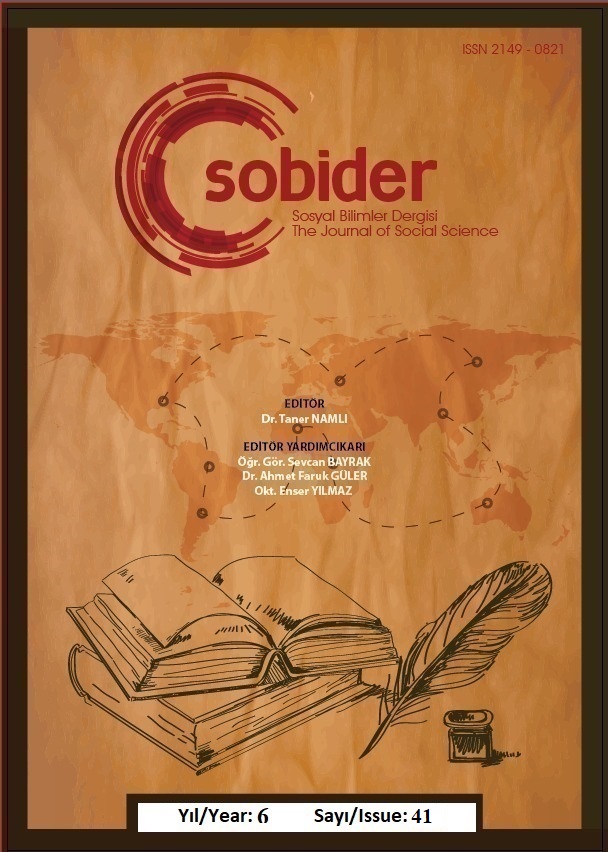Author :
Abstract
Toga, Roma vatandaşlığını karakterize etmektedir. Bu nedenle sadece Roma vatandaşlığına sahip kişiler tarafından giyilmiştir. Toga’nın MÖ 1. yüzyıl başlarından MS 5. yüzyıl sonlarına kadar dört farklı tipi bulunmaktadır. Anadolu Medeniyetleri Müzesi koleksiyonu togalı heykeli ikinci tiptedir (Çizim 2). Heykel, 1990 yılında Ulus İşhanı önünde yapılan cadde kazısında bulunmuştur (Resim 1-3) . Öncelikli olarak toga’nın kökeni ve anlamı üzerinde durulmuştur. Akabinde heykel tanımlanmış ve elbise analizi yapılmıştır. Elbise analiziyle ilk defa Türkçe bir terminoloji oluşturulmuştur. Buradaki Türkçe terimler çok sayıda terzi ile görüşülerek şekillendirilmiştir. Son olarak ise hem Anadolu hem de Roma’dan örneklerle heykel tipolojik ve stilistik açıdan değerlendirilmiştir.
Keywords
Abstract
Toga characterizes Roman citizenship. Therefore, ıt could only be worn by Roman citizens. There are four different types of toga from the beginning of the 1st century BC to the end of 5th century AD. The toga sculpture from Museum of Anatolian Civilization’ collection represents the second type (Drawing 2). The toga sculpture was found during the street excavation in front of the Ulus İşhanı in 1990 (Image 1-3). The origin and meaning of the toga are primarily emphasized. Then, the statue was identified and dress analysis was made. A Turkish terminology was created for the first time by dress analysis. Here, the Turkish terms have been created by negotiating with a large number of tailors. Finally, the sculpture was evaluated typologically and stylistically with examples from both Anatolia and Rome.
Keywords
- Dawid, M. (1980). “Bemerkungen zu zwei Relieffriesen aus dem ephesischen
- Dawid, M. (1980). “Bemerkungen zu zwei Relieffriesen aus dem ephesischen
- Elfenbeinfund”, içinde: F. Krinzinger – B. Otto – E. Walde-Psenner (Ed.) Forschungen undFunde Festschrift Bernhard Neutsch. Avusturya: Innsbrück Üniversitesi Yayınları, 95-102.Dawid, M. (2003). Die Elfenbeinplastiken aus dem Hanghaus 2 in Ephesos: Räume SR 18 und SR 28 Forschungen. Wien: Avusturya Bilimler Akademisi Yayınları.
- Durugönül, S.; Dinç, M.; Tepebaş, U. (2017). “Kilikia Bölgesi Roma Dönemi Heykeltraşlığı”, Arkhe 4: 88-97.
- Ersun, D. (2019). Anadolu’da Togalı Heykellerin Gelişimi: Tipolojik ve Stilistik
- Fejfer, J. (2008). Roman Portraits in Context, içinde: F. Lissarrague – R. M. Schneider – R. R. R. Smith (Ed.), Berlin: De Gruyter.
- Frenz, H. G. (1977). Untersuchungen zu den frühen römischen Grabreliefs. Frankfurt: The Author.
- Gabellone, F. (2012). “La scansione laser terrestre per lo studio di reperti archeologici: ambitidi applicazione e operatività sul campo”, içinde: F. D’Andria – M. P. Caggia – T. Ismaelli(Ed.) Hierapolis di Frigia V: Le Attività Delle Campagne di Scavo e Restauro 2004-2006. İstanbul: Ege Yayınları, 61-68.
- Gabelmann, H. (1985). “Römische Kinder in Toga Praetexta”, JdI 100: 497-541.Goethert, F. W. (1939). “Studien zur Kopienforschung I”, RM 54: 176-219.
- Goette, H. R. (1990). Studien zu römischen Togadarstellungen. Mainz: Verlag Philipp von Zabern.
- Goette, H. R. (2013). “Die römische ‘Staatstracht’ toga, tunica und calcei”, içinde: M.
- Hurschmann, R. (2002). “Toga”, Der neue Pauly 12 (1): 654-655.
- Karanastasi, P. (2013). “Die statuarische Repräsentation der römischen Kaiser im östlichenImperium”, içinde: M. Tellenbach – R. Schulz – A. Wieczorek (Ed.) Die Macht der TogaDresscode im römischen Weltreich. Regensburg: Schnell & Steiner, 94-97.
- Kockel, V. (1993). Poträtreliefs stadrömischer Grabbauten: ein Beitrag zur Geschicte und zum Verständnis des spätrepublikanisch-frühkaiserzeitlichen Privatporträts. Mainz.
- Korkut, T. (2000). “Überlegungen zum Aufkommen der Halbfiguren auf kleinasiatischen Grabstelen vom Hellenismus bis zur römischen Kaiserzeit”, Adalya 4: 181-194.
- Oberleitner, W. (2009). Das Partherdenkmal von Ephesos: Ein Siegesmonument für LuciusVerus und Marcus Aurelius, Schriften des Kunsthistorischen Museums 11A-B.Wien: Sanat Tarihi Müzesi Yayınları.
- Özgan, R. (2013). Roma Portre Sanatı II. İstanbul: Ege Yayınları.
- Smith, R. R. R. (2006). Roman Portrait Statuary from Aphrodisias: Aphrodisias II. Mainz: Verlag Philipp von Zabern.
- Stone, S. (2001). “The Toga: From National to Ceremonial Costume”, içinde: J. L. Sebaste –
- Zanker, P. (1975). Grabreliefs römischer Freigelassener”, JdI 90: 267-315. Zanker, P. (1990). Augustus und die Macht der Bilder. Münih: Beck.
- Wiegartz, H. (1965). Kleinasiatische Säulensarkophage: Untersuchungen zum
- Plinius (1962). Natural History XI, Çev. H. Rackham, Harvard Üniversitesi Yayınları. Tertullian (2005). De Pallio, V. Hunink (Çev.) Turnhout Brepols.
- Vergilius (1965). Aeneas I, Çev. O. Akşit, İstanbul: İstanbul Üniversitesi Edebiyat Fakültesi Yayınları.
- Çizim 1. Toga bölümlerini gösteren renklendirme (Ersun, 2019: 39).
- 3. Tip 4. TipÇizim 2. Toga’nın dört tipinin gösterimi (Ersun, 2019: 155).





